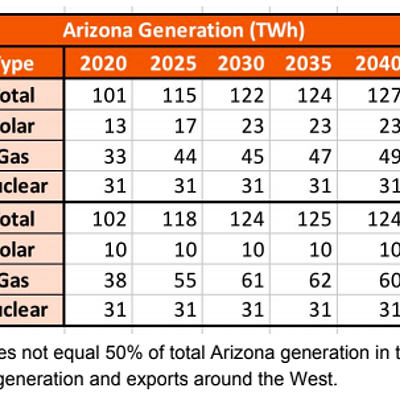"I challenge our nation," Gore declared in a July speech, "to commit to producing 100 percent of our electricity from renewable energy and truly clean carbon-free sources within 10 years."
"We can do it," proclaims Joseph Simmons, professor of materials science and engineering at the UA, and the director of the Arizona Research Institute for Solar Energy. "If money is no object, we're very close to having no technological obstacles to providing the electricity from solar and wind sources."
Simmons acknowledges that achieving the 100 percent target will require a massive national investment, something along the lines of the expenditures on the 1960s Apollo moon mission. "But if we do it," he points out, "the future benefits will be tremendous."
Among the benefits Gore foresees are a reduction in greenhouse gases to ease global warming, and creating jobs to manufacture the required technology.
On the other hand, Simmons says of Gore's challenge: "If money is an object, the 10-year timeline is not realistic."
While federal fiscal realities may prevent the country from meeting Gore's goal, Simmons thinks solar technology and economics will be up to the task.
"In two to three years," he predicts, "we'll be much more able to make solar reasonably close (in cost) to current generators of electricity, if you take into account the lifetime of the system and no fuel charges."
To achieve Gore's proposal, Simmons anticipates four strategically located sites in the U.S., including one in Holbrook, Ariz., would be established as energy storage areas. These facilities would be fed from numerous solar and wind farms situated around the country, and power would be transmitted from them to individual utility companies.
"The future is very bright," Simmons declares, "but we have to have the will."
Much of that required will would need to come from Washington, D.C.
Democratic Congresswoman Gabrielle Giffords applauds Gore for thinking big and stresses that many of the country's greatest accomplishments resulted from big ideas.
Through spokesman C.J. Karamargin, Giffords adds, "The cost of not trying to reach Gore's goal will be even greater (than seeking to accomplish it)."
Republican Tim Bee is hoping to defeat Giffords in November. Given 24 hours to comment prior to the deadline for this story, Bee did not reveal a position on Gore's challenge.
Meanwhile, Tucson Electric Power Company (TEP) has its own challenge. It is working to meet not only the Corporation Commission's 15 percent target, but also a 2008 goal of 1.75 percent.
In April, the commission authorized the utility to increase residential bills up to $2 a month to help finance its renewable energy plan. TEP had proposed $5.20, which led to a split 3-2 ACC vote in favor of the lower amount.
TEP spokesman Joe Salkowski points out the increase wasn't added on to bills until June. He also says the actual increase is expected to be $1.61 on the average residential monthly bill of more than $82.
"It's going to be a challenge given the limited funding and time," Salkowski says of meeting the commission's 2008 goal.
Adding to that hurdle is the fact the company presently produces less than 1 percent of its power from renewable resources. Coal accounts for 78 percent of its energy supply, with natural gas making up much of the balance.
Despite its small present use of renewable energy, TEP is a national leader in solar electric generation per customer. A survey done last year by the Solar Electric Power Association showed the company ranked sixth among all investor-owned utility companies.
To help figure out how to meet the Corporation Commission's ultimate goal of 15 percent, TEP, along with two other Arizona utilities, commissioned a study by the consulting firm of Black and Veatch.
The 2007 report looks at a wide range of renewable options, from biomass and biogas sources to hydroelectric and geothermal. Even with the higher cost of solar power--which may be up to double that of some of the other options according to the study--Black and Veatch concludes two-thirds of the state's renewable need will be met in 2025 from sunshine because of its abundant availability in Arizona.
Salkowski says TEP is now investigating the construction of additional solar facilities, but much depends upon what happens in the nation's capital. Congress has stalled on extending a tax-credit program needed to implement these large solar plants.
On Aug. 1, Giffords wrote congressional leaders about the extension, urging them to bring a bill forward in September. "Failure to extend the tax credits," Giffords noted, "would deal a devastating blow to the U.S. renewable energy industry, just as it is beginning to take off."
For his part, Salkowski indicates: "The tax credits are needed to make the projects pan out. TEP is very supportive of the extension."










